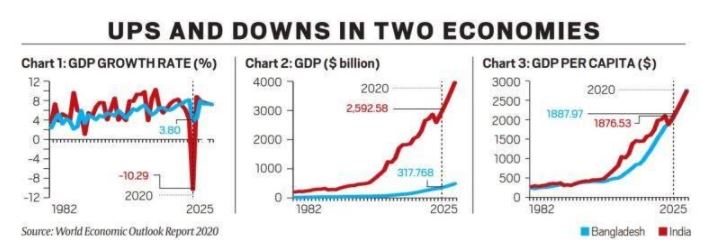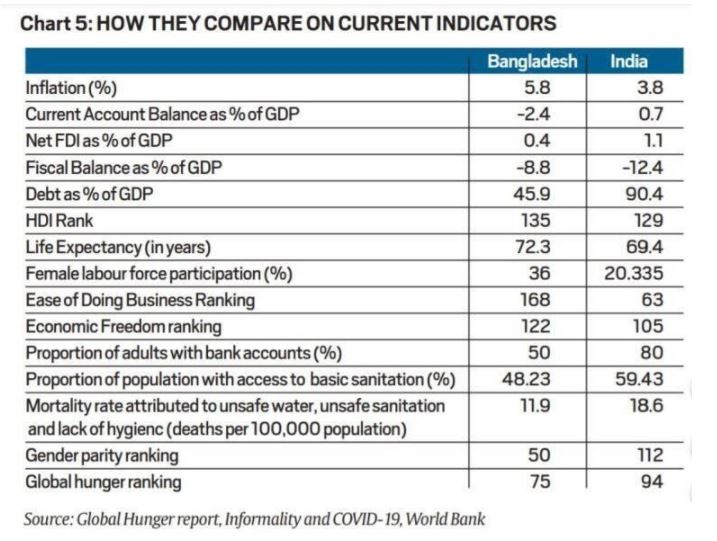UPSC Articles
ECONOMY / GOVERNANCE/ INTERNATIONAL
Topic: General Studies 3:
- Indian Economy and issues relating to planning, mobilization, of resources, growth, development and employment.
India Bangladesh Per capita GDP
Context: The International Monetary Fund’s latest update on the World Economic Outlook.
Key Findings of Report
- In the IMF’s estimation, in 2020, growth of India’s gross domestic product (GDP) will witness a contraction of over 10%
- But more than the sharp contraction, what has caught everyone’s attention is that in 2020, the per capita income of an average Bangladeshi citizen would be more than the per capita income of an average Indian citizen.

Source: Indian Express
How did this happen? Isn’t India one of the world’s biggest economies?
- Typically, countries are compared on the basis of GDP growth rate, or on absolute GDP.
- India’s economy has mostly been over 10 times the size of Bangladesh, and grown faster every year, as can be seen in Charts 1 and 2
- However, per capita income also involves another variable — the overall population — and is arrived at by dividing the total GDP by the total population.
- As a result, there are three reasons why India’s per capita income has fallen below Bangladesh this year.
- First, since 2017 onwards, as Chart 1 shows, India’s growth rate has decelerated sharply while Bangladesh’s has become even faster.
- Secondly, over the same 15-year period, India’s population grew faster (around 21%) than Bangladesh’s population (just under 18%).
- The combined effect of these two factors can be seen in how the per capita GDP gap had closed considerably even before Covid-19 hit (Chart 3).
- Bangladesh’s per capita GDP was merely half of India’s in 2007 — but this was just before the global financial crisis. It was roughly 70% of India’s in 2014 and this gap closed rapidly in the last few years.
- Lastly, the most immediate factor was the relative impact of Covid-19 on the two economies in 2020. While India’s GDP is set to reduce by 10%, Bangladesh’s is expected to grow by almost 4%.
- In other words, while India is one of the worst affected economies, Bangladesh is one of the bright spots.
Has this ever happened earlier?
- Yes. In 1991, when India was undergoing a severe crisis and grew by just above 1%, Bangladesh’s per capita GDP surged ahead of India’s. Since then, India again took the lead.
Is India expected to regain the lead again?
- Yes. The IMF’s projections show that India is likely to grow faster next year and in all likelihood again surge ahead.
- But, given Bangladesh’s lower population growth and faster economic growth, India and Bangladesh are likely to be neck and neck for the foreseeable future in terms of per capita income.

Source: Indian Express
How has Bangladesh managed to grow so fast and so robustly?
- In the initial years of its independence with Pakistan, Bangladesh struggled to grow fast. However, moving away from Pakistan also gave the country a chance to start afresh on its economic and political identity.
- As such, its labour laws were not as stringent and its economy increasingly involved women in its labour force. This can be seen in higher female participation in the labour force
- A key driver of growth was the garment industry where women workers gave Bangladesh the edge to corner the global export markets from which China retreated.
- It also helps that the structure of Bangladesh’s economy is such that its GDP is led by the industrial sector, followed by the services sector. Both these sectors create a lot of jobs and are more remunerative than agriculture.
- India, on the other hand, has struggled to boost its industrial sector and has far too many people still dependent on agriculture.
- Beyond the economics, a big reason for Bangladesh’s progressively faster growth rate is that, especially over the past two decades, it improved on several social and political metrics such as health, sanitation, financial inclusion, and women’s political representation.
Besides the advances it has made, what challenges does Bangladesh face?
- Bangladesh’s level of poverty is still much higher than India’s and still trails India in basic education parameters and that is what explains its lower rank in the Human Development Index.
- The bigger threat to Bangladesh’s prospects emerges from its everyday politics. The leading political parties are routinely engaged in violent oppression of each other.
- In the 2019 edition of Transparency International’s rankings, Bangladesh ranks a low 146 out of 198 countries (India is at 80th rank; a lower rank is worse off).
- Add to this a massive surge of radical Islam, which has resulted in several bloggers being killed for speaking out unpopular views.
- These developments have the ability not just to arrest Bangladesh’s progressive social reforms that have empowered women but also to derail its economic miracle.













